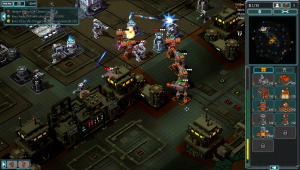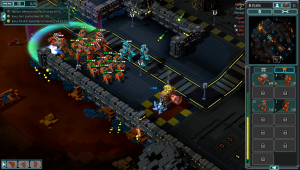On Petroglyph’s 8-Bit Invaders
I’ve been playing through some 8-Bit Invaders during my brief moments of downtime over the past few weeks; we’ve recently stepped up our game on news, and that has -in that strange, ironic way- left me with almost no time to play games of my choice.
8-Bit Invaders, despite the time-consuming stigma that sometimes follows strategy games, has managed to maintain accessibility and keep the skirmish time down, at least for the campaign – I’ve not dabbled with the multiplayer yet.
 The team behind the game, Petroglyph Games, have a habit of bringing out solid RTS games, so I shouldn’t be surprised; Empire at War was excellent, Universe at War was fun, and Grey Goo -most recently- was surprisingly good. They were started by Westwood Studios alumni too, which is as strong a resume a studio can have when it comes to delving into the RTS genre.
The team behind the game, Petroglyph Games, have a habit of bringing out solid RTS games, so I shouldn’t be surprised; Empire at War was excellent, Universe at War was fun, and Grey Goo -most recently- was surprisingly good. They were started by Westwood Studios alumni too, which is as strong a resume a studio can have when it comes to delving into the RTS genre.
There’s always a risk with these things, of course, and you need to be aware of them when you delve into a game. RTS titles can be overburdened by well-wishing mechanics, or poorly designed tech/unit/building trees – think of Stormrise’s Whip mechanic, Halo Wars’ hero units (which could see a game over far too quick), and of course the inevitable fluster that anyone who delves into AOE suffers at the hand of multiple resources, or into Seven Kingdoms suffers at the hand of the taxation, espionage, and trade systems.
 8-Bit Invaders, then, and the 8-Bit series that it’s part of (Hordes & Armies being military & fantasy equivalents), actually strips the RTS genre back to its core.
8-Bit Invaders, then, and the 8-Bit series that it’s part of (Hordes & Armies being military & fantasy equivalents), actually strips the RTS genre back to its core.
There’s only two factions (although multiplayer can, interestingly, feature all six from the 8-Bit series) in the campaign mode, and there’s only one resource to manage – which is accessible to both, and subsequently frequently contested.
New units and buildings, as with most RTS, are unlocked by completing missions, but are then instantly accessible at the start of the next mission – it means that there’s no regimented order to getting to the bigger units, short of setting up and maintaining links to the resource points.
 The resource points are really a capture affair, with a dedicated harvester unit simply having to be stationed at the point in order to feed resources into your pool. Easier still the harvesters automatically head to the nearest when you create them — if you’re off to a strong start then just spam out some more harvesters and tag a few troops along to guard them.
The resource points are really a capture affair, with a dedicated harvester unit simply having to be stationed at the point in order to feed resources into your pool. Easier still the harvesters automatically head to the nearest when you create them — if you’re off to a strong start then just spam out some more harvesters and tag a few troops along to guard them.
My only issue with the early C&C series came from the fact that infantry quickly became redundant as defences and armoured vehicles took the front stage. This is one point where 8-Bit changes things up, and it’s for the better; Infantry remains relevant not just due to its affordability, but due to the fact that they are still powerful, and most of them are anti-air.
 It’s also, in the spirit of Total Annihilation and Supreme Commander, best played with big numbers, in hordes. Although there are most definitely times when sending off a half-dozen of troops to secure a location before you slam an army into the main base of the enemy is completely worth it.
It’s also, in the spirit of Total Annihilation and Supreme Commander, best played with big numbers, in hordes. Although there are most definitely times when sending off a half-dozen of troops to secure a location before you slam an army into the main base of the enemy is completely worth it.
The visual direction of the game is certainly an interesting one, with boxy-voxel style poly-art giving it an almost lego-like charm and accessibility. While that style is certainly a little bit overdone in other genres, it really suits the RTS genre.
The game’s campaign seems to be about 8-10 hours long, with over a dozen missions each for the two factions. I’ve really been enjoying my time with it, and will hopefully get to sit down and finish it, and get a review out for it at some point.
Comments are closed.